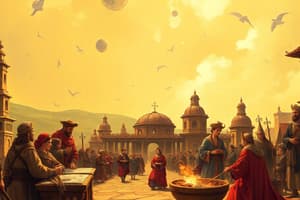Podcast
Questions and Answers
Social shifts from the middle ages to the renaissance included the end of the ________________, which had killed millions of people.
Social shifts from the middle ages to the renaissance included the end of the ________________, which had killed millions of people.
Black Death
Living closely together in cities led to the increased discussion and spread of ________________.
Living closely together in cities led to the increased discussion and spread of ________________.
New ideas
The political structure of Italy helped support the Renaissance because there was no centralized monarchy; instead, Italy had independent ________________.
The political structure of Italy helped support the Renaissance because there was no centralized monarchy; instead, Italy had independent ________________.
city states
Certain individuals called ________________ used their wealth as a way to gain political _______________.
Certain individuals called ________________ used their wealth as a way to gain political _______________.
The Renaissance also began in Italy because of economic developments, such as competition for sea trade routes, the exchange of ideas in foreign ports, deposit banking, and banks issuing bills of ________________.
The Renaissance also began in Italy because of economic developments, such as competition for sea trade routes, the exchange of ideas in foreign ports, deposit banking, and banks issuing bills of ________________.
Changes in art, literature, and scholarship were influenced by the interest Italians had in the ancient _______________________.
Changes in art, literature, and scholarship were influenced by the interest Italians had in the ancient _______________________.
Interest in the idea of 'back to the sources' or __________________, led scholars to learn Hebrew so that they could read early versions of the old testament.
Interest in the idea of 'back to the sources' or __________________, led scholars to learn Hebrew so that they could read early versions of the old testament.
Italian architects employed five different types or, ________________ of columns in their designs.
Italian architects employed five different types or, ________________ of columns in their designs.
One of the richest city states was ________________, which was at the center of major trade routes.
One of the richest city states was ________________, which was at the center of major trade routes.
The northern Italian city state of ______________ served as a link between ______________ and western Europe.
The northern Italian city state of ______________ served as a link between ______________ and western Europe.
In the northern Italian region of Tuscany, Florence became a major power because of its cloth manufacturing and banking, which was greatly benefitted by the ______________ family.
In the northern Italian region of Tuscany, Florence became a major power because of its cloth manufacturing and banking, which was greatly benefitted by the ______________ family.
Naples, in southern Italy, became occupied by French forces led by King ______________ in the late 1400's.
Naples, in southern Italy, became occupied by French forces led by King ______________ in the late 1400's.
The Papal states, which were controlled by the Catholic church had their capital in _____________, which was invaded by Spanish forces in 1527.
The Papal states, which were controlled by the Catholic church had their capital in _____________, which was invaded by Spanish forces in 1527.
In The Prince, Machiavelli espoused the belief that a leader must do ___________ when possible but be ready to do ______________ as necessary.
In The Prince, Machiavelli espoused the belief that a leader must do ___________ when possible but be ready to do ______________ as necessary.
Machiavelli argued that a leader should not be concerned with _______________ because it was unrelated to politics.
Machiavelli argued that a leader should not be concerned with _______________ because it was unrelated to politics.
Study Notes
Social Changes
- The transition from the Middle Ages to the Renaissance marked the end of the Black Death, which had a significant death toll.
- Increased urbanization led to enhanced social mobility and interactions among different social classes.
Ideas and Cultural Exchange
- Living in cities facilitated the discussion and spread of new ideas.
- The Renaissance was characterized by a revival of interest in ancient Greek and Roman cultures.
Political Structure of Italy
- Italy's lack of a centralized monarchy allowed for the growth of independent city-states, each with its own political dynamics.
- Wealthy individuals known as signori utilized their resources to obtain political power.
Economic Factors
- Competition for trade routes and the establishment of banking practices, including bills of exchange, contributed to the economic foundation of the Renaissance.
- Italian architects integrated five distinct orders of columns in their architectural designs to reflect classical influences.
Educational Developments
- The motto 'ad fontes' emphasized a return to original sources, prompting scholars to learn Hebrew for direct access to early biblical texts.
Major City-States
- Milan, a key city-state, gained prominence through trade and a structured tax system established by the Visconti and Sforza families.
- Venice served as a crucial trade link between Asia and Western Europe, flourishing due to its maritime trade empire and shipbuilding industry.
- Florence became an economic powerhouse in Tuscany due to cloth manufacturing and banking, significantly supported by the influential Medici family.
Conflicts for Control
- Naples faced occupation by French King Charles VIII in the late 1400s, leading to prolonged conflicts between France and Spain over Italian territories.
- The Papal States, governed by the Catholic Church, had Rome as their capital, which suffered an invasion by Spanish forces in 1527.
Political Philosophy
- In "The Prince," Machiavelli discussed the necessity for leaders to balance good actions with the potential for evil deeds in the pursuit and maintenance of power.
- Machiavelli argued that morality should not influence political decision-making; instead, leaders should focus on understanding human nature to benefit the state.
Studying That Suits You
Use AI to generate personalized quizzes and flashcards to suit your learning preferences.
Description
Explore the key social and cultural shifts that occurred during the Renaissance and Reformation periods. This quiz highlights major events such as the aftermath of the Black Death and the rise of new ideas in urban settings. Test your knowledge and enhance your understanding of this transformative era in history.





